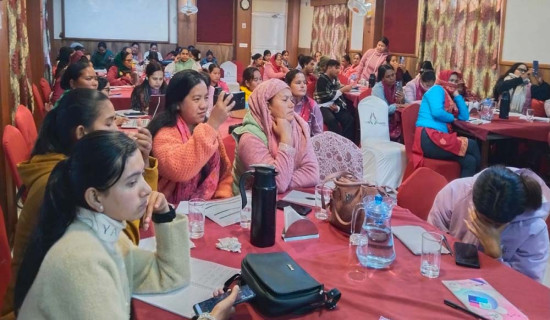- Wednesday, 24 December 2025
Print Has A Future
Aashish Mishra
We live in an online, digital world today. Everything we have and everything we will have in the decades to come will be online and digital. Technology has got us in a stranglehold and we cannot escape it no matter how hard we try – our life requirements will not allow us to, as anyone who has ever tried, and failed, to quit social media can attest. This is not to say that digital is bad. On the contrary, the convenience and speed they offer have made them an essential part of our modern lives. But that begs the question, with the increasing digitisation, do print media have a future?
There is an irony to be acknowledged that the scribe is questioning the future of print media through an article in the print media and he acknowledges it. But this is a question that bears posing, especially today as the nation’s oldest surviving newspaper Gorkhapatra marks the 122nd year of its publication.
So, does print media have a chance in a digital world? The answer is yes for a very simple reason – credibility. This is not a claim against the authenticity of online media. The lack of filtering and gatekeeping often makes digital forums more truthful than the biggest names in print journalism in the market. But there is so much on online platforms coming from so many sources that it gets hard to distinguish what is real and what is not.
Let us understand it this way, would we believe an ad printed in a newspaper or one forwarded via link on WhatsApp?
When it comes to the virtual world, we often overestimate people’s abilities to adapt to it. Print has been around in different forms for thousands of years and is ingrained in every element of our civilisation, from culture to cosmetics to education to entertainment. Online has been around for less than a generation and even the most “modern” of us still only prefer it in small periodic doses. The proof: Several newspapers that went online at the start of the COVID-19 pandemic saw their readership, employee performance and advertisement revenue dwindle and had to come back to print. Those that tried to persist lost their public standing. The people, at least in Nepal, are okay with a digital element which is part of a larger printed world but are not yet comfortable giving up the page for a screen.
Print helps in conveying and comprehending content like nothing else. This concept not only applies to news but nearly everything. That is why we still have printed visiting cards, physical signboards and paper certificates.
On the flip side of the coin, print media is also necessary for the entities that do business with them. Print ads choose not to move online because despite having wider reach, they have less of an impact. People can block online ads through various browser settings and applications or turn a blind eye to pop-up ads. In newspapers and magazines, people do not have the same luxury and also, people tend not to ignore something that is physically in front of them. Print ads at least get a passing glance while digital ads may be overlooked entirely. That is why organisations feel safer providing ads (and money) to print media and are willing to invest in their survival.
Social media and the variety of targeted options they offer have started to lure advertisers away from not just print media but traditional media as a whole and the future of print advertising is far from certain. But things are not quite there yet and print ads remain valuable. That is why big brands like McDonald’s, Rolex, BMW and others still advertise in print.
Print also provides the sturdy foundation that digital stands on. There are only a few digital media that people know of and seek out independently. Otherwise, most others are followed for the reputation of their print counterparts. People go to websites of other newspapers to check out the news printed on those publications while readers visit gorkhapatraonline because of the brand created by Gorkhapatra over the past century. The print is the bedrock upon which the digital stands. That is why print media still has a future.

















